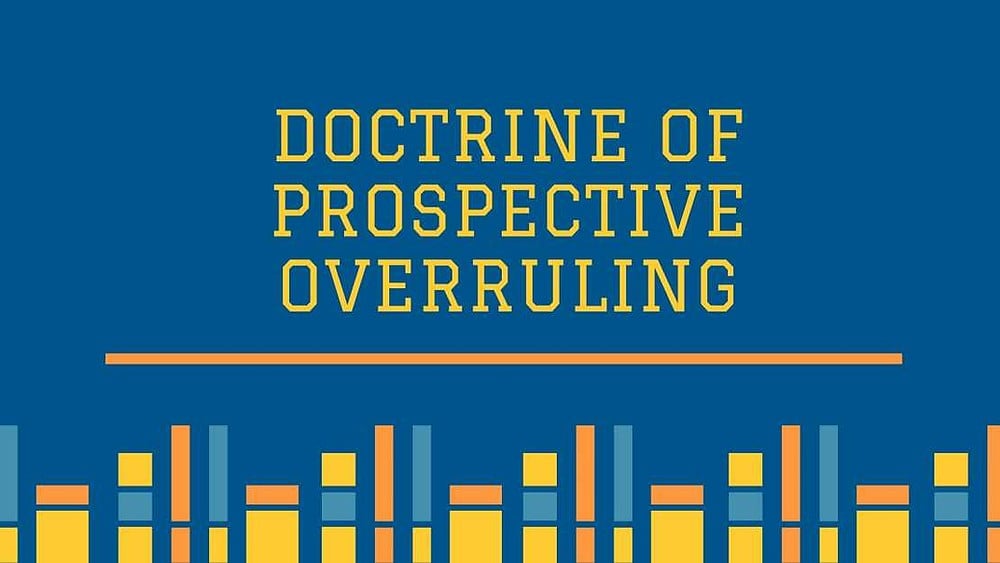Doctrine of Prospective Overruling
The Supreme Court of India recently clarified the application of the doctrine of prospective overruling. This ruling emerged from criminal appeals against a Delhi High Court judgment. The High Court had upheld trial court orders, stating no legal violation under the Narcotic Drugs and Psychotropic Substances Act, 1985. The Supreme Court’s two-judge bench emphasised that invoking this doctrine should not be routine and must be justified by circumstances.
Doctrine of Prospective Overruling
The doctrine of prospective overruling allows a court to declare that a new legal principle applies only to future cases. This is done to avoid injustice or confusion that may result from sudden legal changes. It helps ensure smooth legal transitions by protecting actions done under the old rule.
Origin & Usage in India
- The doctrine came from U.S. courts and was adopted in India.
- First used in India in the case Golak Nath v. State of Punjab (1967).
- The Supreme Court uses Article 142 of the Constitution for this doctrine – this Article allows the Court to do “complete justice” in any case.
Use Cases
- Used only in constitutional cases.
- Can be applied only by the Supreme Court.
- Past actions under old law are not disturbed.
- Prevents reopening old cases and unnecessary litigation.
- Gives time to adjust to the new rule.
Landmark Cases
Golak Nath v. State of Punjab (1967)
- First time the doctrine was used in India.
- Court said Parliament cannot change fundamental rights.
- But to avoid confusion, this rule applied only to future cases.
Chevron Oil Co. v. Huson (1971) – USA Case
- Gave 3 conditions to apply the doctrine:
- The ruling must be a new legal principle.
- Court must look at pros and cons of applying it to past cases.
- If applying to the past causes injustice, apply it only to future.
India Cement Ltd. v. State of Tamil Nadu (1990)
- States collected a tax (cess) that was later declared invalid.
- The Court applied the doctrine to avoid refunding all taxes collected.
Managing Director, ECIL v. B Karunakar (1993)
- Concerned employee rights during disciplinary action.
- The Court applied the ruling only prospectively to avoid hurting the administration.
Municipal Council, Kota v. Delhi Cloth Mills (2001)
- Court upheld a tax and did not use the doctrine.
- Shows that prospective overruling is used carefully, not always.
Jindal Stainless Ltd. v. State of Haryana (2017)
- Overruled past rulings about trade and tax laws.
- Despite requests, the Court did not apply it prospectively – the new rule applied even to old cases.
Recent SC Ruling
- Recently, the Supreme Court ruled that if a new judgment overrules an earlier one, the new judgment applies to past cases too. This is because it explains the correct law, which might have been wrongly understood because of the old judgment.
- So, all past transactions and cases (except already closed ones) are judged by the new interpretation.
- The Court said it is not making new laws, but clarifying or correctly interpreting existing ones. A judge’s role is to discover and explain the correct law, not to create law.
- A judgment will apply only in the future (prospectively) only if the Court clearly mentions it in the decision. Otherwise, it is automatically retrospective.
- Cases that are already decided (res judicata) or settled accounts will not be reopened, even if an earlier judgment is overruled.
Context of the Case
- The decision was made while hearing a case under the NDPS Act.
- The Court was examining whether Buprenorphine Hydrochloride (a psychotropic substance in the NDPS Schedule but not in its Rules) could be used to convict someone.
Month: Current Affairs - April, 2025
Category: Legal & Constitution Current Affairs







